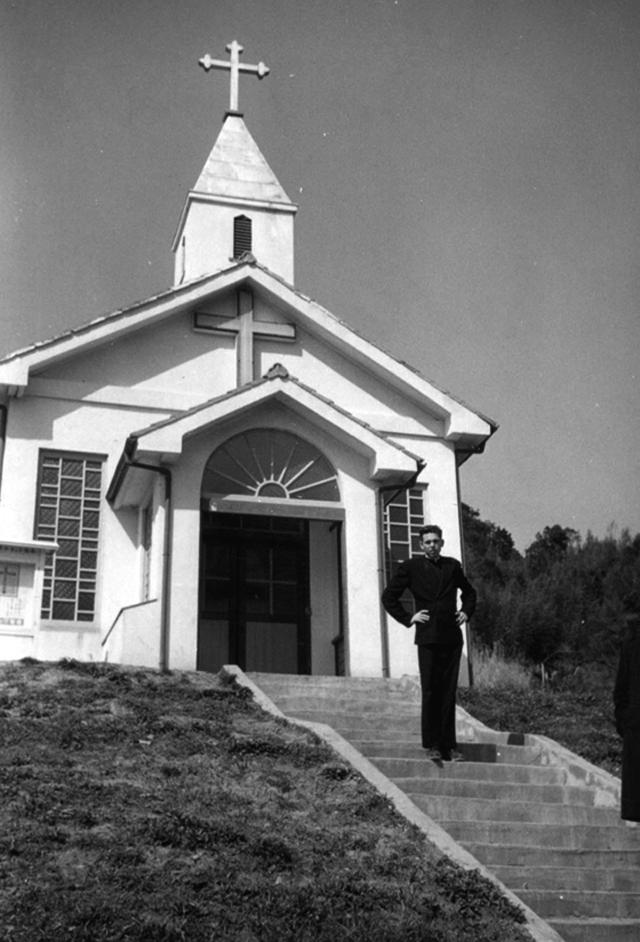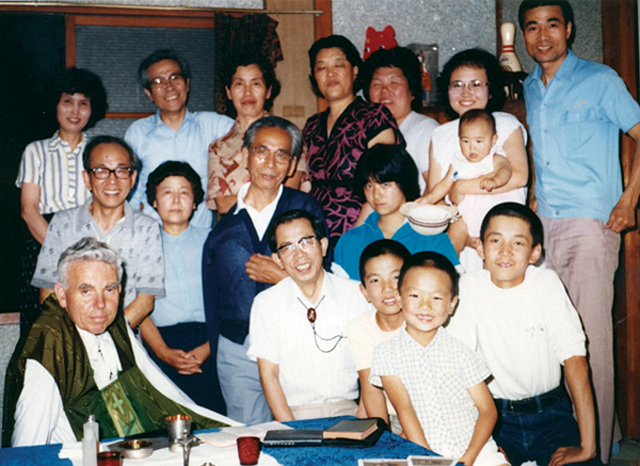A happy beginning
The four years spent in my first parish provided the momentum for the remaining 44 years of my missionary journey in Japan
By Fr. Alex McDonald, S.F.M.
December 2007
Return to Table of Contents
Print Article
I will always remember that morning in early September 1955 as I stood on the platform of the railway station in Kaize, Japan, suitcase in hand. Across the tracks was a steep hill covered with rice paddies and on top of the hill was a pretty wooden church flanked by a hall and rectory all newly painted in bright yellow. I had been in Japan three years, two spent studying the language in Tokyo and the third year as curate to Scarboro Father Mike Cox in the parish of Shimabara near the city of Nagasaki. After just one year as curate I was to be pastor of that church on the hill.
 In 1955, not long after he was missioned to Japan, Fr. Alex McDonald was assigned to the new parish of Kaize as its first pastor.
In 1955, not long after he was missioned to Japan, Fr. Alex McDonald was assigned to the new parish of Kaize as its first pastor.
Until now Kaize had been a mission station of Scarboro Missions’ parish of Tawaramachi in the city of Sasebo, but with my appointment as its first pastor, Kaize was to become a full-fledged parish. The church, rectory and hall had been built recently by the two priests in Tawaramachi. With mixed emotions I gazed at those buildings above the rice paddies. I felt excited at the challenge, but also a deep sense of apprehension. After only one year as a curate I was very green and still struggling with this difficult language.
The priests in Sasebo told me that Kaize was the main town but the parish area included three other towns. The majority of the people were coal miners who lived in houses owned by the mining company. In each of the three outlying towns there were about a hundred Catholics who could not attend mass very often because of the distance. However, the mining company owned a community hall in each town for use by their employees and kindly allowed us to use the hall for services one Sunday afternoon each month.
When I arrived, the total number of Catholics was 600, but as a missionary I had been repeatedly taught that our role was not just to minister to the Catholics but also to preach the gospel to the unevangelized.
When I was in the parish of Shimabara there was a full time Japanese catechist who gave instruction to those interested in becoming Catholic. In Kaize I was on my own. Two days after settling in, a young lady rapped on the rectory door and told me she wanted to become a Catholic. I didn’t recognize her but she said that she was the salesgirl who sold me flowers the day before. I had gone to the florists to buy flowers for the altar in preparation for my first Sunday.
The young woman was soon joined by others. After a year of patiently putting up with my broken Japanese, my first class of catechumens was baptized, the first fruits of my apostolate.
Not long after my arrival in Kaize, the Superior of a group of Australian Sisters who ran a high school in Sasebo asked me if I would be interested in teaching religion one day a week to their students. I agreed and that turned out to be a great love because it forced me to work hard to improve my language skills.
My first Sunday
On my first Sunday in the parish about 200 parishioners showed up. After mass, I was introduced to the leaders and to the Sunday school teachers. It was a pleasant surprise to see how well organized they were. It was also reassuring to know what a great help they would be in this my first parish.
One Sunday, about a month later, a young woman with a baby on her back told me that she had walked two hours that morning to attend Mass. She said she lived on a plateau called Muta no Hara where there were 30 families homesteading on land recently given them by the government. They had migrated from the Goto islands off the coast of Nagasaki and 29 of the families were Catholic and one family was Buddhist.
 The people welcomed Fr. Alex throughout his years of mission in Japan and he often celebrated Mass at the homes of Japanese Catholics.
The people welcomed Fr. Alex throughout his years of mission in Japan and he often celebrated Mass at the homes of Japanese Catholics.
That afternoon I walked back with her up the mountain to Muta no Hara. Her home was a large rambling farmhouse where she lived with her husband, children and elderly in-laws. The family offered me the use of their home for mass and catechetical instruction. I accepted and Mura no Hara became the first mission station in the parish of Kaize.
Every Saturday afternoon I taught catechism to the children there, had supper with the family and spent the night sleeping on the tatami, a straw mat, in the room they had set aside for me. At six o’clock every Sunday morning the people of the plateau gathered for mass in the Yumashita home. By this time I had purchased a motorcycle so I could get there on time for mass.
In Muta no Hara I had one catechumen, the eldest son in the only Buddhist family on the plateau. Attracted by the example of the Catholics he asked for instructions in the faith and after his baptism he joined the Trappist Monks.
In those days property and building costs were cheap. After six months Scarboro gave me the funds to build a small chapel in Muta no Hara with a room attached where I could stay overnight. The people were thrilled on the Sunday when Archbishop Yamaguchi of Nagasaki came to do the blessing. To the people of Muta no Hara this humble chapel was their magnificent cathedral.
After four years in Kaize I was transferred to my second parish, Ichinomiya, in the diocese of Nagoya where I was to spend the next 44 years. In the priesthood, as in every other vocation in life, a happy beginning is invaluable. I’m so grateful to the Lord for those four years in my first parish. They were happy years, a good beginning indeed, one that provided the momentum for the remaining 44 years of my missionary journey in Japan.
Return to Table of Contents
Print Article